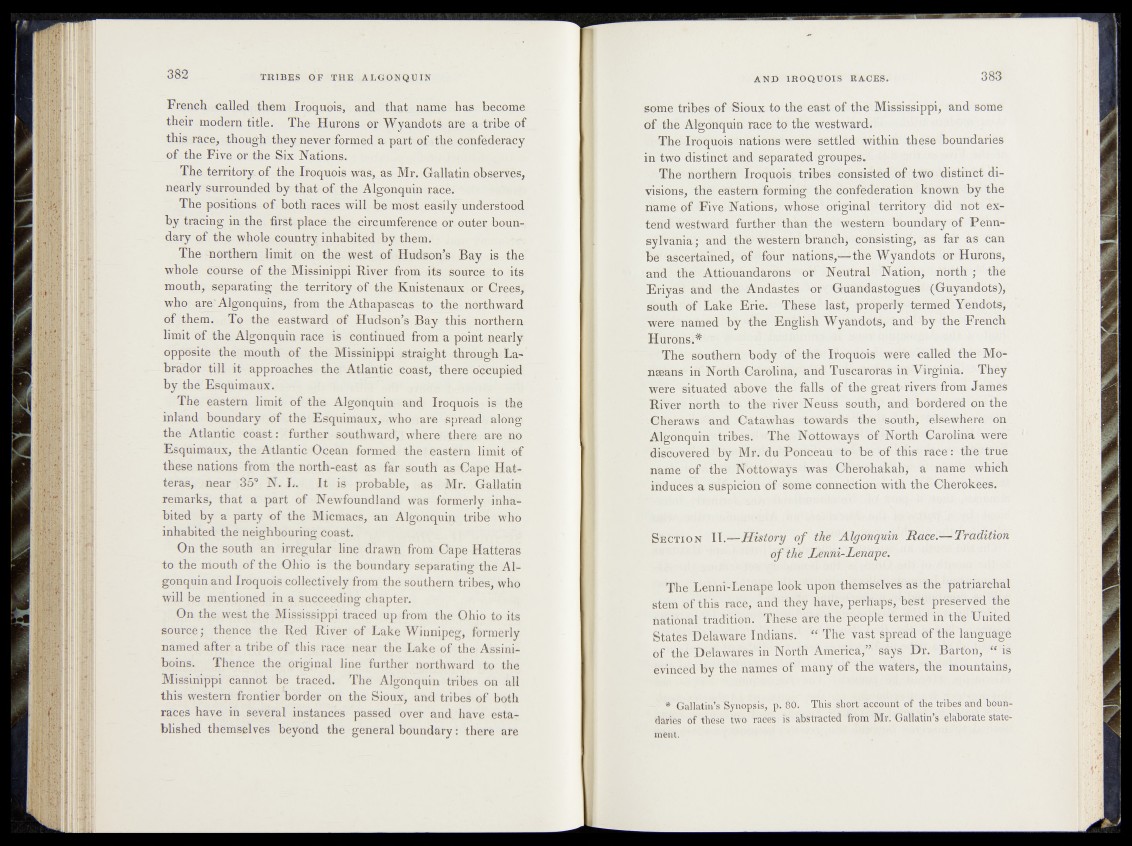
French called them Iroquois, and that name has become
their modern title. The Hurons or Wyandots are a tribe of
this race, though they never formed a part of .the confederacy
of the Five or the Six Nations.
The territory of the Iroquois was, as Mr. Gallatin observes,
nearly surrounded by that of the Algonquin race.
The positions of both races will be most easily understood
by tracing in. the first place the circumference or outer boundary
of the whole country inhabited by them.
The northern limit on the west of Hudson’s Bay is the
whole course of the Missinippi Fiver from its source to its
mouth, separating the territory of the Knistenaux. .or Crees,
who are'Algonquins, from the Athapascas to the northward
of them. To the eastward of Hudson’s Bay this northern
limit of the Algonquin race is continued from a point nearly
opposite the mouth of the Missinippi straight through Labrador
till it approaches the Atlantic coast, there occupied
by the Esquimaux.
The eastern limit of the Algonquin and Iroquois, is the
inland boundary of the Esquimaux, who ,are spread along
the Atlantic coast: further southward,; where-;there are no
Esquimaux, the Atlantic Ocean formed the eastern limit of
these nations from the north-east as far south as Cape Hat-
teras, near 35* N. L. It is probable, as Mr. Gallatin
remarks, that a part of Newfoundland was formerly inhabited
by a party of the Micmacs, an Algonquin tribe who
inhabited the neighbouring: coast.
On the south an irregular line drawn from Cape Hatteras
to the mouth of the Ohio is the boundary separating the Algonquin
and Iroquois collectively from the southern tribes, who
will be mentioned in a succeeding chapter.
On the west the Mississippi traced up from the Ohio to its
source; thence the Red River of Lake Winnipeg, formerly
named after a tribe of this race near the Lake of the Assini-
boins. Thence the original line further northward to the
Missinippi cannot be traced. The Algonquin tribes on all
this western frontier border on the Sioux, and tribes of both
races have in several instances passed over and have established
themselves beyond the general boundary: there are
some tribes of Sioux to the east of the Mississippi, and some
of the Algonquin race to the westward. -
The Iroquois nations were settled within these boundaries
in two distinct and separated groupesv
The northern IroqhotSv tribes consisted of two distinct divisions,
the eastern forming the confederation known by the
name of Five-Nations, who^e1 original1 territory- did not extend
westward further than the western' boundary of Pennsylvania
; and the-western branch) consisting, as far as can
be ascertained, of four nations,1^ the Wyandots* or Hurons,
and the AttiOuandaronS^or Neutral Nation, n o rth ; the
Eriyas and the Andastes '^CGjdandas^iCS5 (Guyandotitb
south of Lake Erie. These last, properly termed Ychdots,
were named by the English Wyandots, and by the French
Hurons.#
The southern body of the Iroquois' were called the’Mo-
nseans in North Carolina, and Tuscaforas in?'Virginia. They
Were situated above the falls of the great*rivers from James
Rivef north to the river Neuss south, and bordered on the
. Gheraws and Catawhas towards the south;'telsewhere on
Algonquin tribes. The Nottowayr of !North Carolina were
discovered by Mr. du Ponceau to-be Of this* race': the true
name of the> Nottoways- was OlWrohakah, a namfe Vhich
induces a suspicion of some connection with the Cherokees.
S e c t io n I I .—History o f the Algonquin Race,— Tradition
o f ike Zenni-Lenape.
The LennhLenape l‘6ok%pon themselves hS'the patriarchal
stem of this race, and they hai&, perhaps, bes't^plfiSrved the
national tradliton. These are the'ph'o^lh termed- in the United
States Delaware Indians/ 1W The{ v a st^ red d Öf'the language
of the Delawares in North America/’' ssd$sf Dr. Barton, “ *is
evinced by the names of many df the waters, the mountains,
* Gallatin’s 'Synopsis, p. ÖÖ. This short accou(ni; of the tribes alid boun-
iärfes of these two races iS abstracted from Mr, Galiatiti’s elaborate statement.